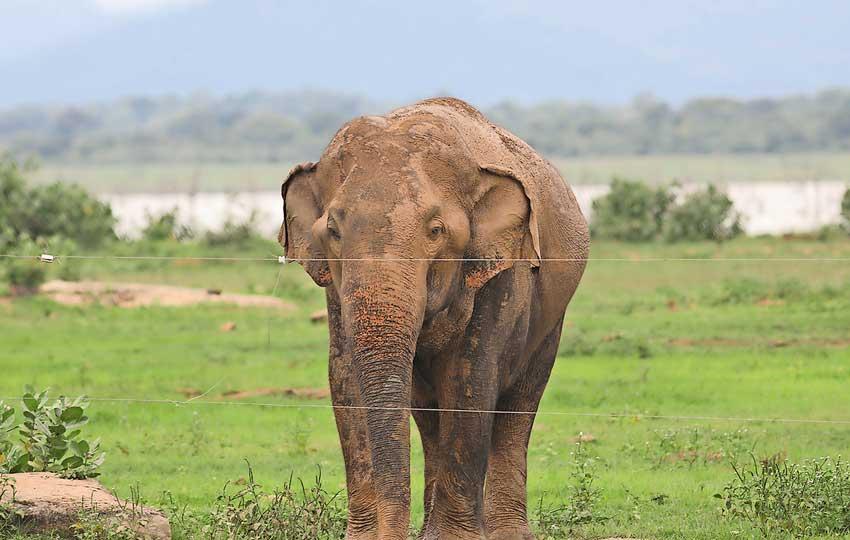Reply To:
Name - Reply Comment

 No. Not THAT elephant, nor the one which turned itself into a telephone. Neither are in the room. The compass is not in the room either and there’s palpable evidence that even the lotus bud has got displaced. That’s if ‘people’ constitute ‘the room.’
No. Not THAT elephant, nor the one which turned itself into a telephone. Neither are in the room. The compass is not in the room either and there’s palpable evidence that even the lotus bud has got displaced. That’s if ‘people’ constitute ‘the room.’
These days, the proverbial elephant in the room is the Coronavirus. The room is enormous and constitutes almost the entire landmass of the earth or rather those parts inhabited by humans. Today we are told that the virus is going to hang in there for quite a while, vaccines notwithstanding. We are told that we better resolve to live with the virus.
The elephant we are talking about is a tad larger than the virus. We are talking about the pachyderm, the behemoth, the elephant. Elephas maximus. And the room is the country or at least almost two-thirds of the territory.
There are problem-elephants but it is a problem that humans create in the main. The fact that around 1,000 elephants have been killed between 2017 and 2019 indicate that removing the so-called ‘problem elephants’ is not a sustainable solution.

I am not an elephant expert. However, a recent paper titled, ‘First country-wide survey of the endangered Asian elephant; towards better conservation and management in Sri Lanka’ written by people who have studied the issue for a long time does shed some light. The article, principally authored by Prithiviraj Fernando, breaks it down to numbers.
There are approximately 6,000 elephants in Sri Lanka and over 4,000 of them are likely to use areas where people also live. Elephants roam in 59.9% of the island. Of the landmass a 44% slice is shared by both species. Put another way, people are resident in 69.4% of the elephant range. In other words, the ‘Human-Elephant Conflict Zone’ encompasses almost the entire Dry Zone of the country.
Given this spatial distribution and the behavior of both species, we should not be surprised at the outcome. There are fatalities on both sides. The factor that precipitates an act of aggression can vary, but deep down it is about both species wanting to survive. Individual humans and individual elephants both share a will to live and a fear of death.
For the past 61 years, the principal approach has been containment of elephants to protected areas and driving those outside into the same, as recommended by the Committee on Preservation of Wildlife appointed by the then government. Initially, it was just elephant drives but it was found that the creatures backtracked to their original locations, some of them walking over 100 km to what they consider to be their ‘home range’. So, in the early 1990s, the authorities came up with the idea of electric fences. It is reported that there are around 4,500 km of fencing at present. Studies have shown that herds thus driven do not explore the protected terrain, but remain in comparatively small areas in the direction of their home range. They typically overuse their habitat and eventually face starvation.
Another problem with this strategy is that the fences have been erected on the border of territories that come under the Department of Wildlife Conservation (DWC) and the Forest Department, following the basic strategy of holding elephants in protected areas. So in effect there are elephants on either side of these fences. Human encroachment on Forest Department lands obviously invites conflict. The obvious solution is to move the fences to the boundary that separates forest from human settlements.
That however is only in places proximate to protected areas. As the above data indicates, elephants roam far afield from what we are taught to believe are their ‘habitat’ or the areas that humans have marked as ‘elephant land’ so to speak.
The solution has to take into account the fact that the elephant is in the room. Right in the middle of it. Right in your face or rather the face of the Dry Zone citizen. In other words, the conflict occurs almost entirely outside protected areas. For example, the study conducted by Fernando and his team concludes that the conflict remains a serious issue even in areas such as Polonnaruwa, Puttalam and Hamabantota where electric fencing of protected area boundaries have been completed. The study details the biological and ecological reasons including elephant behavior and carrying capacity which contributed to the failure of this strategy.
The study also points out that increasing the carrying capacity of protected areas is not economically feasible. Apparently it costs around Rs.2.4 million a year to increase the carrying capacity of a protected area by a single elephant. Thus, it would cost close to a billion rupees a year if we extrapolated to the approximately 4,000 elephants living in ‘peopled’ areas.
One of the human-centric ‘solutions’ proposed and implemented, if informally, has been to shoot the elephants. It’s a simple argument: either you die or I die and I do not wish to die.’ It’s not exactly ‘shoot on sight’ but people do empathize with would-be victims shooting what are called ‘rogue elephants.’ Yes, there are rogue elephants who attack and kill for reasons that are not apparent to humans. And sometimes when it is not possible to distinguish the rogue from the innocent you shoot anyway, ‘erring on the side of caution’.
Well, there are rogue humans too and don’t we know about these! Just as the average human cannot distinguish rogue, we can speculate, the elephant too has an identification problem and could also ‘err on the side of caution’.
There is another human-centric position that seeks a solution this side of ‘getting rid of the beast,’ you know, the kind of thing that many animal lovers abhor perhaps because their lives are not at stake and who, in their innocence, arrogance or outright ignorance, berate governments and relevant departments for not doing enough to save our ‘gentle’ giants. This position is one that takes into account ‘The elephant in the room,’ literally.
We need to take into account that elephants are not naturally aggressive towards humans and it is typically their experience with our species that make them belligerent. There are problem-elephants but it is a problem that humans create in the main. The fact that around 1,000 elephants have been killed between 2017 and 2019 indicate that removing the so-called ‘problem elephants’ is not a sustainable solution.
What has worked is a strategy that goes for coexistence. Living with the elephant, so to speak. No, it’s not about elephants and humans being all lovey-dovey all of a sudden. We live with snakes, we live with dogs who get infected with rabies. We take precautions. We protect households and communities. What has worked is community-fencing. They are eminently pragmatic given that large-scale drives have not and cannot work.
Of course such a strategy would have to be accompanied by awareness-creation campaigns, protection of ‘protected areas’ — poaching, livestock grazing and invasive plants remain serious issues that need to be addressed. Most of all, there’s a need to get the facts right and peruse them with sobriety.
The bottom line, of course, is that a sixty-year strategy has not worked. Bad medicine will not work just by increasing the dose. Misidentification of the ailment will obviously lead to erroneous prescription. There is an elephant in the room; not in the rooms inhabited by humans who don’t have to worry about face-to-face encounters with pachyderms but out there in almost the entire Dry Zone. That elephant is not going to move.
[email protected]
www.malindawords.blogspot.com